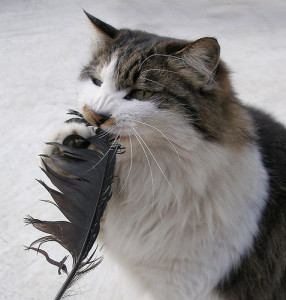
(Photo: Tanakawho/Flickr via Creative Commons)
Killer Bees, Kudzu and Milfoil are often cited as familiar examples. So are gypsy moths, starlings and zebra mussels.
But did you know that approximately 35% of all US households harbor an animal that is included among the top half of “100 of the World’s Worst Invasive Alien Species?”
Other mammals rounding out the the top half of the Global Invasive Species Database include goats, red deer and mongoose.
And cats.
Why are cats considered an invasive species?
A non-native species is considered invasive when it poses a threat to the environment, economy or human health.
According to a recent study published in the journal Nature Communications, cats are responsible for considerably higher death rates of birds and mammals than previously thought.
The study estimates that cats are responsible for more than one billion bird deaths and more than 7 billion mammal deaths annually.
The majority of these deaths are the result of feral cats, rather than pets
While the study makes a distinction between mortality rates resulting from feral and domesticated cats, pets remain responsible for a large number of deaths. Feral cats appear to be responsible for slightly more than twice the deaths as compared to “owned” cats.
Cats are natural hunters, and will instinctively hunt when given the opportunity. Many cat owners have stories of their pets proudly presenting a freshly killed bird or small animal at their feet.
How can killer cats be controlled?
Feral cat spay and neuter programs have had some success in curbing population growth. While spaying or neutering can reduce the urge of a cat to roam, it typically will have no effect on its hunting instincts.
Confining an “outdoor” cat is a tough call for many cat lovers. Cats love the exercise and stimulation of being out of doors. Many pet owners are comfortable with the “out of sight, out of mind” approach to the behavior of their cats once the door closes behind them.
Responsible cat ownership should include monitoring your cat’s activities. At the very least, attaching a bell to your cat’s collar will alert birds and small animals to the presence of a potential predator. This will give them a chance to return or warn their family without mishap.
Cats are still part of our families
Even though they are considered an “invasive species”, your cat doesn’t have to share the behavior that has lumped their species in with mongoose and goats.
A bit of diligence, or the addition of a small bell, will go a long way in preserving some of the wildlife in your own eco-system.
Want a bell for your outdoor cat’s collar? Let us know and we’ll be happy to include one at no charge as part of your next order. Available while limited supplies last!
Have a look at the full list of 100 of the World’s Worst Invasive Alien Species here and read the summary of the Nature Communications report here.

I’ll look up the original to study to see how the investigators differentiated truly feral cats (those with no human socialization who live outdoors all the time) from pet cats who are allowed outdoors. I’ve read that the worst killers are indoor/outdoor cats because they don’t kill in order to eat. They kill for what we humans would call “sport.”
An easy way to make sure a pet cat doesn’t kill anything–keep it indoors. Yes, that means a litter box or two, which needs to be scooped at least daily. Yes, the pet owner has to provide an enriched environment indoors. Window-sill perches, scratching posts, cat trees set up for easy viewing of outdoor activity, the occasional pot of wheatgrass–all of these are easy enough to do. Free equipment can sometimes be found on FreeCycle groups; low-cost cat “furniture” can be found at thrift stores, too. Add in an interactive play session once or twice a day, and an indoor cat is every bit as happy as one outdoors. And safer. And healthier. And with a much longer lifespan, on average.
Great tips, Barbara. Thanks for your thoughts.
The graphic that accompanied the article appeared to show a much higher mortality rate attributed to feral cats. Their notes stated that an estimate for the number of “non-owned” cats was used to extrapolate in the study, since no studies have been done to determine that number.
While it seems that the number of cats kept indoors is growing, we’ve still got a long way to go!